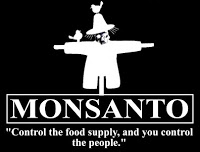Also involved in the study were rodents — clearly a dietary staple of the French, and biologically (or psychologically?) identical to certain English academics.
The “evidence” cited in the study shows that — at least to monocled marsupials — GM plants are “nutritionally equivalent to their non-GM counterparts and can be safely used in food and feed.” Of course “food and feed” are not exclusive aspects of GM agriculture — or even agriculture — but corporate-sponsored research has its own perspective . . . Never mind the trace minerals and everything else!
As usual, the slashdot comments were many, and the views varied; organic versus conventional, ridicule and support of both, with lots between — all shedding light on people’s views of the subject. Admittedly, geeks may not be the best authority on such topics — often compiled of pizza and soft-drinks — but I fear they do provide an example of popular opinion regardless. Many see GM as a noble science, helping to feed the world’s growing population. Some see “organic” anthropocentrically, reducing it to a matter of pesticides, nutrition, and prices. Few seem to have a balanced perspective though.
Conventional versus organic agriculture – or where to begin:
Crop rotation gets little attention, probably due to most consumers having no familiarity with processes behind the supermarkets. Most GM crops are mono-cultures, and are rarely if ever rotated. Mono-cultures reduce biodiversity, having effects far beyond the farm, and unrotated crops stress and deplete the soil. While the terribly important subject of biodiversity is generally ignored in conventional agriculture, soil quality is maintained artificially through mined fertilizers and industrial chemicals. There are quite a few implications for this; the dust-bowl of the US, and creeping deserts of China are but a few. Artificial fertilization requires strip mining, particularly for phosphates, and the effects are harsh. Pollution of watersheds, eutrophication, devastation, and even radiation are effects of phosphate mining.
In 2003, Piney Point phosphate mine threatened to leak a hundred-plus million gallons of contaminated water into Tampa Bay. Instead of allowing it to leak, Jeb Bush authorized it to be dumped into the Gulf of Mexico. I clearly remember suffering perennial red-tide for more than a year after the first incident. In June of 2011, Piney Point threatened to leak again.
Piney Point was officially an “accident”; possibly one less expensive to pay the fines for, than to build a more secure infrastructure. But conventional agriculture is not an accident, and a look at the Mississippi Delta dead-zone is an example some of the consequences involved in run-off from fertilization.
We’ve all heard horror stories of cattle threatening to fart our beloved planet into a toxic stink-osphere. …Sure, but what they leave out is that it is not just farts, but mismanagement of the manure which produces much of this dangerous surplus of methane. Instead of properly redistributing the manure to be returned to the soil, it is often stuffed in squalid vats to putrefy without benefit — emitting methane. Could such manure not substitute these mined phosphates to some extent?
The argument that to feed the growing population we must genetically modify our crops and practice industrial agriculture is worth some attention, as it is perhaps the most popular argument supporting the industry. This argument confuses many, and irritates some like myself. One must at a minimum, consider the waste of conventional agriculture, where rather than composting and returning detritus to the soil, it is either burned, trashed, or used for other industrial purposes. Organic agriculture it is not entirely self-sufficient, but it is far more so than its contestant. Between hydroponics and more – but smaller – farms, organic (and perhaps eco-farming) could indeed maintain pace with the demands of our growing population — all while remaining far more symbiotic with ecosystems.
The French study also neglects aspects of what they claim to understand of feed. Bees are critical to agriculture, and certainly are not well hosted by conventional farms. Some studies have suggested that GM corn pollen may weaken the intestinal walls of bees, thus reducing resistance to parasites and other infections.
We know that feeding corn — as opposed to grass — to cattle increases putrefaction due to excessive starches (sugars), further leading farmers to grotesque measures; boring permanent holes into the stomachs of cows to monitor the bacterial cultures that arise from corn diets of GMO-powered starchiness, and the excessive antibiotics which become necessary as result of the intestinal imbalances caused by such diets. In humans, GM soy has been proposed to threaten intestinal flora as well, by transferring corrupted DNA into beneficial flora.
Patent-wars are another issue, and could alone make a strong case against GMOs. Whether through cross-pollination (contamination) or terminator seeds, the patent has been used to harm many farmers and sustain what would otherwise fail under fair and wholesome circumstances. Organic farming claims no ownership of nature; it seeks to work in relative harmony, and cares not to bully fellow farmers. The notorious Monsanto has been a true tyrant in this regard, litigating farmers into bankruptcy, and playing dice with biology. It is no secret that the FDA and Monsanto are close, and that neither exhibit any sincere concern for the health of the masses. They present GM science as the road to a thriving humanity, but their real motives are clearly profit — without regard to humanity’s common interests.
We also need to bring agriculture closer to home, whereever possible. By this I imply less dependence on centralized farming, and more local cooperation. The supermarket shelves can be emptied, but our yards are alive, and our greenhouses belong to us. We should be teaching ourselves the basics of growing what we can in our climates, and becoming less reliant on those who care neither about their own produce, animals, or us. Where this cannot be done, one may try to act supportively instead, whether in words or coins.
What seems objectively obvious to me is that GMOs are understudied, abused, resented by many, and will have to wait in a very long line for any truly conclusive research. Organic agriculture, however, is tried and proven — and no one resents its products. I know from experience the differences of that grown on the local farm here in Sarasota, compared to that bought in any grocery store — and they are quite apparent; from the way I feel after enjoying them, to the politics — or lack thereof — that are involved. I know of no organic farm sporting prison labor, but I can surely name a few conventional farms that do. I don’t want an institution supper, nor do I want corporate mutations in my mouth. The differences are clear, and it’s a shame that they even need be argued — but ’tis our times and tyrants.
There is much, much more to cover on this subject, though I wanted to get this out in time to wish the Activist Post readership (and syndicates) a Merry Christmas for all those who celebrate it, and the kindness of the holiday spirit to everyone, which will hopefully some day no longer be once per year.
Owen Myles writes and edits the Eccentric Intelligence Agency: Helping the Ouroboros finish itself.
linkwithin_text=’Related Articles:’




Be the first to comment on "Merry Monsanto — Military Industrial Agriculture"